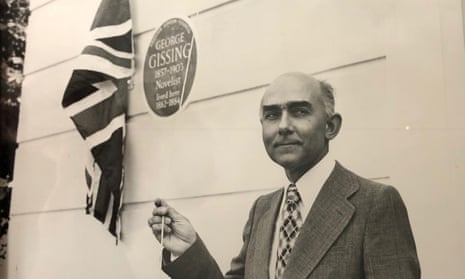Few literary scholars have laboured quite so devotedly in the service of a single subject as Pierre Coustillas, who has died aged 88. Certainly, the fervour he brought to his half-century campaign to restore the reputation of the Victorian novelist George Gissing went well beyond the usual boundaries of scholarly interest.
As well as bringing out new editions of Gissing’s works, co-founding the Gissing Journal, staging academic conferences in his memory and producing a mammoth three-volume biography, Coustillas also assembled a collection of books from his hero’s library and acquired pieces of his furniture. So relentlessly did talk of Gissing’s life, work and opinions cascade through the Coustillas household that his daughter’s first words are supposed to have been “Morley Roberts” – the name of an obscure professional crony of Gissing’s from the 1890s.
Born at Neuville-aux-Bois, near Orléans, the son of René Coustillas, a stationmaster, and his wife, Marie-Thérèse, and educated at the Sorbonne, where he later obtained a teaching post, Coustillas was eventually appointed founding director of the Victorian studies centre at the University of Lille. This remained his base for the rest of his academic life.

vividly describes the poverty in this part of north London. Photograph: Heritage Images/Getty Images
The origins of the Gissing project dated to 1968 when John Spiers, a PhD student and fledgling publisher at the recently established University of Sussex (“a new institution with a lot of money but an empty library,” Spiers remembered) invited Coustillas to prepare a scholarly edition of the “impossibly scarce” two-volume Isabel Clarendon (1886), a Gissing work so neglected by posterity that it was thought only six copies had survived a fire at the original publisher’s warehouse.
At this point Gissing studies were at a low ebb. It was not that the author of such late-Victorian classics as The Nether World (1889), New Grub Street (1891) and The Odd Women (1893) was entirely forgotten – George Orwell had been a fan, and a pioneering biography by Jakob Korg had appeared in 1962 – merely that so many of his books were out of print.
Over the next decade, under the auspices of his Harvester Press imprint, Spiers, in collaboration with Coustillas, set about remedying this deficiency, reissuing 18 of the novels. London and the Life of Literature in Late-Victorian England (1978), an edition of Gissing’s diaries, provided a portrait of the fin-de-siècle literary lifestyle was so uncompromising that one reviewer diagnosed a plot got up by the Society of Authors aimed at deterring new recruits to an over-populated trade.
A two-volume life of Gissing had been announced in a Harvester Press catalogue in the early 1980s, but Coustillas had another quest in view: a scholarly edition of Gissing’s correspondence. Co-edited with the American scholars Paul F Matheisen and Arthur C Young as The Collected Letters of George Gissing, and with Coustillas doing most of the work, this appeared in nine fat volumes between 1990 and 1997.
As with Gissing’s diaries, the editing was little short of fanatic: in one epic footnote Coustillas managed to track down an unrelated George J Gissing, some of whose post Gissing had mistakenly received while living at an address in Brixton. The same remorseless high standards were applied to the 600-page George Gissing: A Definitive Bibliography (2005).
Meanwhile, the biography had entered into legend. It was rumoured that Coustillas had despaired of ever producing anything that would do Gissing justice, or, alternatively, had produced a manuscript so long that nobody could afford to publish it. In the event, The Heroic Life of George Gissing appeared in three volumes between 2011 and 2012.
Dense, detailed and unsparing in its exposure of Gissing’s unhappy private life (his first wife was a prostitute who died in conditions of abysmal squalor), it was also defiantly partisan. Gissing’s critics, family members who failed to recognise his genius, insufficiently respectful fellow-authors, disapproving clergymen (he was a convinced atheist) – Coustillas lambasted them all.
Of the reviewers of Human Odds and Ends (1898), for example, he remarked: “The more crassly unintelligent of them are at least significant indexes of the poor intellectual qualifications and benighted turn of mind of some critics, whose notion of literature was both simplistic and arch-conventional.”
Exhausted by the effort of finishing The Heroic Life – he turned 80 in the year the final volume was published – Coustillas sank into a torpor, unable to write or study but occasionally taking pleasure from being read to.
In his decline, as in his scholarly career, he was supported by his wife, Hélène (nee Albert), whose untiring absorption in his work extended to typing every word about Gissing that her husband wrote, and who survives him, along with their daughter, Françoise.

Comments (…)
Sign in or create your Guardian account to join the discussion